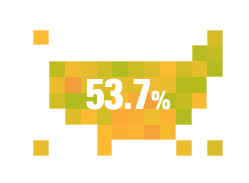The new data are clear: More Americans are learning and training beyond high school to pave powerful paths to well-paid jobs. But progress amid challenges is slow, leaving too many adults without college degrees or other credentials to struggle in their careers and lives.
The dire costs of ending formal education at high school can last a lifetime and impede opportunity from one generation to the next. To combat this, Lumina Foundation in 2008 set an ambitious goal for the nation: By 2025, 60 percent of working-age adults would earn a college degree, certificate, industry-recognized certification, or other valuable credentials. [2025 update: that goal is now 75 percent by 2040.] In the 15 years since, 48 states set education attainment goals that also tackle persistent racial gaps, with help from partners at statehouses to college campuses to boardrooms.
So, how are we doing? New federal data from 2021, reported on Lumina’s Stronger Nation website, show solid progress, with the largest two-year gain since we began tracking these numbers. Nearly 54 percent (53.7%) of working-age adults have earned college degrees or other credentials, up from 51.9 percent in 2019. Several states, including Massachusetts, Utah, Colorado, and Minnesota, moved faster, topping the national average for adults ages 25 to 64. The District of Columbia has the highest attainment rate, at 72.4 percent.
It’s encouraging that the nation’s attainment rate has climbed from 37.9 percent in 2008 and has grown every year, even during the pandemic and economic crises. That’s thanks to hard work, strong partnerships, and better measurement. But racial disparities persist in attainment between Black, Hispanic, Native American, and Alaska Native adults and their white and Asian American peers. Ensuring plentiful opportunities and equitable outcomes for everyone who wants to learn is the only way to achieve lasting results.
Our Stronger Nation site—an interactive, transparent, easy-to-navigate tool available to everyone—holds us accountable by tracking progress, not just for the nation, but also at the state, county, and metro levels. Crucially, that information is disaggregated by race, ethnicity, age, and credential type. This combination helps to paint a nuanced, data-rich portrait of areas of both promise and challenge.
Speed it up
These new data reinforce our urgent need to speed up progress, especially knowing that tomorrow’s students – our future leaders – will be even more racially, socially, and generationally diverse. To meet their needs in a fast-changing labor market, educators will have to rethink, reinvent, and adapt their policies and practices. Fueled by the pandemic, we’ll need broader opportunities for affordable remote and hybrid learning.
Seeing the gaps and the opportunities for continued progress helps us to sharply focus our efforts as we move forward. With fresh insights from these new data, it’s up to us to help the people behind the numbers – our families, neighbors, co-workers, and fellow citizens – as we ensure that all Americans have equal opportunities to learn, grow, and contribute their talents.
We will need sustained, equity-minded, broad-based, proactive efforts. We will need tightly coordinated education, economic development, and workforce policies as waves of people seek better lives through timely, accessible, affordable learning.
Let’s use these latest data to inform and inspire fresh ideas and bold innovations on behalf of today’s learners and generations to come. Only then will we create a truly stronger nation.

